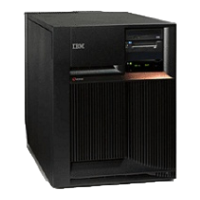v No: You have found the first half of a ″failing″ link. Choose from the following options:
– If this is your first time through steps 1 through 7, go to step 8 (See page 86).
– If this is your second time through steps 1 through 7, go to step 9 (See page 86)
6. Record the HSL resource name, type-model, part number, and port.
7. Is the resource name the same name that you recorded for the NIC in step 4 (See page 85)?
v No: The display that appears is showing the status of the HSL ports for the next I/O Bridge
resource on the loop. Go to step 5 (See page 85).
v Yes: You have followed the HSL links around the loop and back to the NIC on the system. You did
not find a failed link. Return to the procedure that sent you here.
This
ends the procedure.
8. Follow the steps in the Clean and properly seat the cables (See page 86) procedure below.
9. Choose from the following options:
v If the status of the ″Leading port to next resource″ has become ″operational″, the problem has
been corrected. Return to the procedure that sent you here.
v If the status is still not ″operational″, continue with the next step.
10.
If the resource type (shown near the top of the screen, just below the bus number) is an HSL I/O
Bridge, then, perform the Collect the resource information (See page 86) procedure below. Then,
continue with the next step.
11. Select Follow leading port to move to the resource with the failed link on the trailing port. If that
resource is an HSL I/O Bridge, then perform the Collect the resource information (See page 86)
procedure below. Then, return to the procedure that sent you here.
This ends the procedure.
Collect the resource information
Find the information for the failing HSL I/O Bridge using the following steps:
1. Record the resource name, card type-model, part number, and port.
2. Select Cancel to return to the Work with high-speed link (HSL) resources display.
3. Select Resources associated with loop for the loop with the failure.
4. Select Associated packaging resources for the HSL I/O Bridge with the resource name that you
recorded.
5. Record the frame ID.
6. Select Display detail and record the card position.
7. Go to step 11 (See page 86).
Clean and properly seat the cables
Determine if the HSL cable connectors for this HSL I/O Bridge are properly seated and clean:
1. Disconnect the cable labeled port 0 at the frame ID of the HSL I/O bridge .
2. Is the connection an optical link?
v No: Wait at least 30 seconds, and then continue with the next step.
v Yes: Clean the HSL cable connector and port using the tools and procedures listed in symbolic FRU
“OPT_CLN” on page 407. Then, continue with the next step.
3.
Reconnect the cable to the port.
Attention: You must fully connect the cable and tighten the connector’s screws within 30 seconds of
when the cable makes contact with the port. Otherwise, the link will fail and you must disconnect and
reconnect the cable again. If the connector screws are not tightened, errors will occur on the link and it
will fail.
4. Disconnect the cable labeled port 1 at the frame ID of the HSL I/O Bridge .
86 iSeries: iSeries Server 270, 800, 810, 820, 825, 830, 840, 870, 890, SB2, and SB3 Hardware Problem Analysis and Isolation

